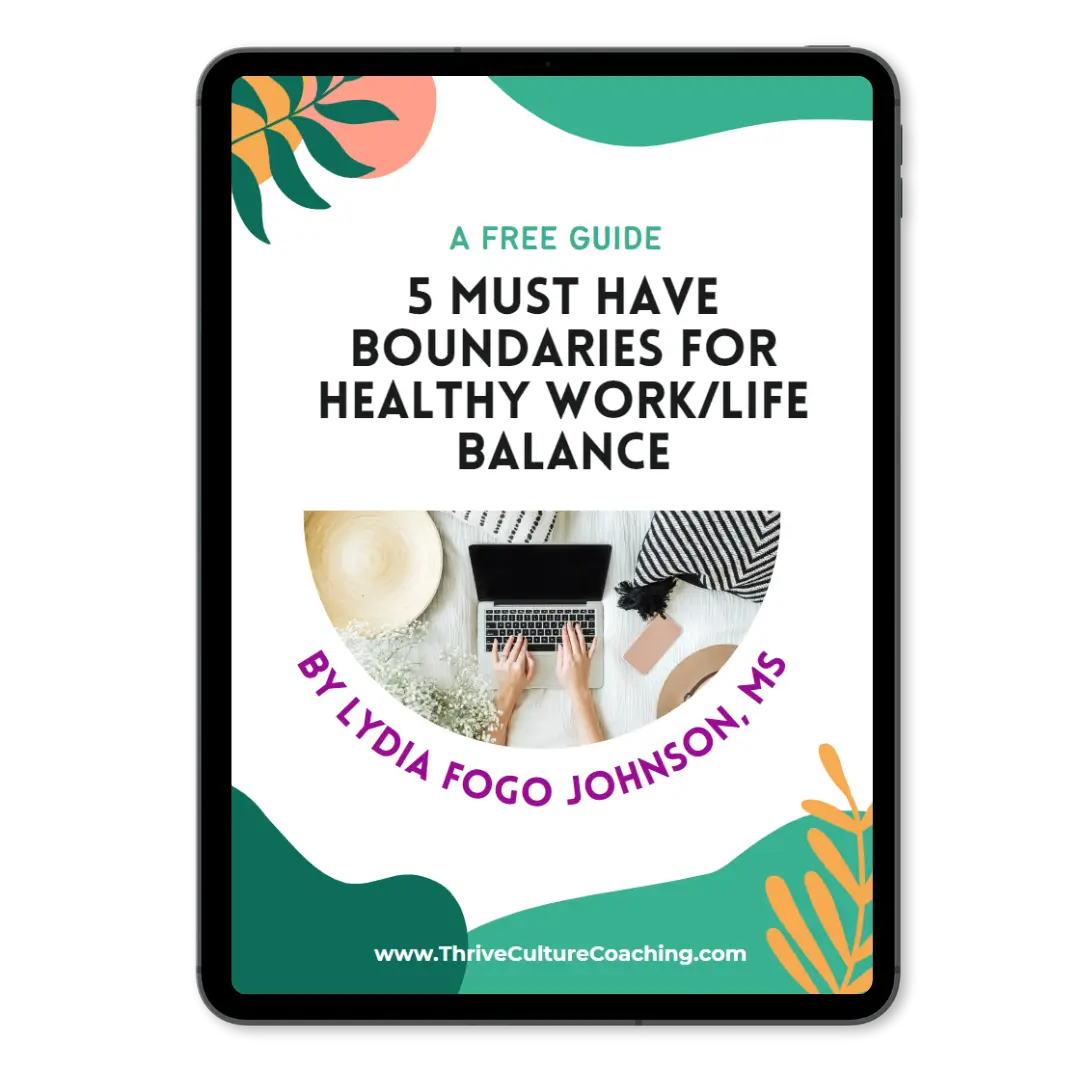Table of Contents
- Introduction
- What Causes Burnout? (It’s Not Just About Working Too Much)
- External Factors: When the System Is Out of Balance
- Societal, Cultural, and Industry Pressures
- Internal Risk Factors: When You Carry Too Much Alone
- Your Burnout Prevention Plan
- 1. Spot Your Red Flags Early
- 2. Create Boundaries for Better Work-Life Balance
- 3. Maximize Time Off with True Recovery and Self-Care
- 4. Use Stress-Relief Tools That Actually Work (in the Moment)
- 5. Untangle the Internal Patterns That Fuel Burnout
- 6. Increase Your Meaning and Impact at Work
- 7. Delegate, Prioritize, and Simplify
- 8. Improve Time Management (Without Hustling Harder)
- 10. Know When It’s Time to Get Out
- Bonus: How to prevent burnout on your team if you’re a leader
- Conclusion: Your Personalized Burnout Prevention Plan Starts Here
Introduction
If you’re like most ambitious women, you’re probably no stranger to the toll of chronic stress. You’re juggling leadership at work, responsibilities at home, and a constant pressure to keep it all running smoothly. Which means you’ve likely felt the slow creep of burnout—mental fog, irritability, fatigue that no weekend seems to fix.
So if you’ve ever wished someone would just hand you a personalized burnout prevention plan, you’re in the right place.
Burnout is a real, research-backed phenomenon. It’s not about being weak or disorganized—it’s what happens when your inner resilience gets worn down by unrelenting demands and too little recovery time. While true prevention requires shifts at every level—individual, team, and organization—this guide focuses on what’s in your control. After all, it’s you reading this article, not your HR leader.
Inside, you’ll find evidence-based strategies to help you recognize the early signs of burnout, protect your energy, manage stress effectively, and reshape your work life so it feels more sustainable. This isn’t about pushing harder. It’s about creating space to breathe, recalibrate, and feel like yourself again.
Let’s get started.
What Causes Burnout? (It’s Not Just About Working Too Much)
Burnout is complex. It’s not just about doing too much — it’s the result of multiple forces working against your well-being. These include external conditions in your workplace, internal patterns you’ve developed over time, and the broader societal messages that tell women we should always be “on.”
If you’re burned out, it doesn’t mean you’re broken. It means you’ve been living in systems that demand too much, offer too little support, and often reward the very behaviors that lead to burnout in the first place.
Let’s break it down where your workplace burnout might be coming from so you can better understand how to create a plan to avoid burnout.
(Pst– Did you know you can experience burnout outside of the workplace, too? For example, moms can experience motherhood stress, leading to mom burnout.)
External Factors: When the System Is Out of Balance

According to the Job Demands-Resources (JD-R) model, burnout happens when high job demands (like pressure, complexity, or emotional labor) aren’t matched by adequate resources (like autonomy, support, and recovery time). This mismatch wears down your mental, emotional, and physical capacity over time.
Common external burnout drivers include:
- Unmanageable workload or constant urgency
- Little control or autonomy over how you work
- Unclear expectations or shifting priorities
- Lack of recognition or community support
- Value misalignment, such as working in an environment that ignores your ethics or wellbeing
Even in jobs you love, these imbalances can quietly drain you until there’s nothing left to give.
Societal, Cultural, and Industry Pressures
Beyond the workplace, there are cultural and systemic forces that push burnout from the background to the baseline — especially for women.
- Always-on digital culture, where disconnecting feels impossible
- Toxic hustle norms, where productivity is treated like a moral virtue
- Capitalist standards of constant output, valuing efficiency over well-being
- Gendered expectations, where women carry more emotional and invisible labor
- High-burnout industries, like healthcare, education, tech, and nonprofits, where chronic stress is normalized
These conditions create a backdrop of pressure that makes burnout feel inevitable — but it isn’t. Awareness helps us recognize what’s not ours to carry alone.
Internal Risk Factors: When You Carry Too Much Alone
Internal patterns also play a role — not because you’re weak or unmotivated, but because we’ve been trained to over-function, over-give, and equate our worth with performance. Common burnout-amplifying traits include:
- Perfectionism and never feeling like you’ve done enough
- People-pleasing and saying yes when you need to say no
- Work as identity, where your role defines your value
- Highly sensitive person or empathetic nature, making emotional labor more taxing
- Ongoing life stressors, like caregiving, illness, financial pressure, or family tension — these reduce your resilience at work even if your job itself seems “fine”
- Human giver syndrome, when you’ve internalized the belief that you have to unconditionally serve and please others.
You might be navigating a tough job, while also holding up a household, caring for others, or managing your own inner critic. That layered load is what makes burnout both personal and systemic.
Test it out:
Reflect on your current state: What part of your burnout feels environmental? What part feels internal? What part feels cultural? Naming these layers helps you respond with more clarity and self-compassion.
Your Burnout Prevention Plan
Preventing burnout isn’t about being more disciplined or squeezing in another morning routine. It’s about protecting your energy, recovering consistently, and working in a way that aligns with your values and needs — not just your output.
The strategies below are grounded in evidence, designed for ambitious women, working moms, and female leaders juggling real-life demands, and focused on helping you feel like yourself again. Each one includes a small action step to help you apply the idea right away.
1. Spot Your Red Flags Early

Burnout rarely hits all at once. It builds slowly — tension in your shoulders, sleep that doesn’t feel restful, or creative work that suddenly feels harder than it should. One of the most effective ways to prevent burnout is to catch these subtle signs before they spiral.
For example, one of my own earliest red flags is when my creativity disappears or I struggle to get started on tasks I usually enjoy. That’s often my cue that stress is accumulating beneath the surface — even if I’m still technically functioning.
Other common early signs include:
- Irritability or detachment
- Trouble concentrating or making decisions
- Loss of motivation for tasks you normally enjoy
- Sleep disturbances, even when you’re tired
- Feeling resentful toward work or colleagues
These signals might not scream “burnout,” but they’re your nervous system waving a red flag.
Develop a habit of checking in regularly. You could rate your stress levels from 1–10 at the end of each week or jot down what felt energizing vs. draining. Small reflections can help you notice when it’s time to slow down before your body forces you to.
Test it out:
Set a 5-minute check-in every Friday: How stressed did I feel this week (1–10)? What drained me? What fueled me? Noticing patterns early gives you power to pivot.
2. Create Boundaries for Better Work-Life Balance
Burnout thrives when work spills into every corner of your life. Without boundaries, your mind and body stay in go-mode long after the day ends — and chronic stress becomes your baseline.
Setting boundaries isn’t selfish; it’s a strategy for sustainability. It helps protect your energy and gives you the space to reset. That includes time boundaries (like no work after dinner), physical boundaries (closing your laptop and walking away), and mental boundaries — the often-overlooked skill of truly detaching from work in your mind.
If you’re still ruminating about emails while cooking dinner or replaying conversations at 10 PM, your nervous system doesn’t get the reset it needs. One helpful tool to reduce burnout is mindfulness practice. Even short daily habits — like mentally labeling any work worries as “I’m working in my head right now” and gently redirecting — can help your brain transition out of work mode.
Test it out:
Choose one small but firm boundary to test this week. For example: “I don’t respond to messages after 6 PM,” or “I leave work devices outside the bedroom.” Watch how even one consistent limit creates breathing room.
(Need more practical work-life balance examples? Check out this article for 30 practical ideas.)
3. Maximize Time Off with True Recovery and Self-Care
Burnout isn’t just about working too much — it’s about not recovering enough. Your off-hours are the only time your body and brain can truly recharge. But if that time is filled with chores, passive scrolling, or numbing out, you’re not actually refueling. Similarly, sometimes we accidently fall prey to faux self-care (e.g., performative or product-based self-care) that doesn’t truly refuel our capacity.
True recovery is active. It includes quality sleep, movement, time in nature, unstructured rest, and hobbies that spark joy or creativity. These moments replenish your emotional and cognitive reserves — so you’re not running on fumes by midweek.
Restorative activities don’t have to be elaborate. A walk without your phone, 15 minutes with a favorite book, dancing in your kitchen, or gardening can all count. What matters is that they bring you back to yourself.
Test it out:
Block off one “me hour” or “me night” in your calendar this week. Use it for something purely restorative — not productive, not obligatory. Think: painting, stretching, listening to music, or anything that feels nourishing. Protect it like any other priority.
4. Use Stress-Relief Tools That Actually Work (in the Moment)
When stress spikes — in the middle of a meeting, after a harsh email, or as your to-do list spirals — you need tools that help you regulate right then. This isn’t about fixing everything. It’s about calming your system enough to think clearly and stay grounded.
These are your SOS tools — small, immediate practices that signal safety to your nervous system. Research shows even brief interventions can reduce cortisol, lower anxiety, and prevent stress from escalating into full-blown overwhelm.
Try:
- Box breathing: Inhale for 4, hold for 4, exhale for 4, hold for 4. Repeat 3–4 rounds.
- 5-4-3-2-1 grounding: Name 5 things you can see, 4 you can feel, 3 you can hear, 2 you can smell, 1 you can taste.
- Labeling emotions: Say to yourself, “I’m feeling pressure,” or “That email triggered some frustration.” Naming the emotion calms the brain.
- Take a posture reset: Unclench your jaw, drop your shoulders, and stand up to move — even briefly.
These tools might seem small, but used consistently, they give you back your power in stressful moments.
Test it out:
This week, pick one SOS strategy (like box breathing) and try it in the moment the next time your stress flares. The goal isn’t perfection — it’s practicing regulation so you stay steady under pressure.
5. Untangle the Internal Patterns That Fuel Burnout
Sometimes burnout isn’t just about your workload — it’s about the stories you’ve internalized about who you have to be. For high-achieving women, the pressure to be perfect, available, productive, and needed can lead to chronic overextension, even in supportive environments.
These internal patterns often go unnoticed because they feel like personality traits. But they’re often shaped by culture, trauma, or social conditioning. Common burnout-amplifying patterns include:
- Perfectionism: If it’s not flawless, it’s not enough.
- People-pleasing: Saying yes to protect your reputation, relationships, or sense of safety.
- Achievement-based self-worth: Feeling valuable only when you’re succeeding or proving yourself.
- Enmeshment with work: Your job becomes your identity.
- Avoiding rest: Equating downtime with laziness or guilt.
These patterns aren’t flaws — they’re protectors. But they can slowly push you past your limits, again and again.
Unpacking them requires curiosity and self-compassion. Start by noticing the beliefs that fuel your overworking. Then ask: Who taught me this? What would I say to a friend in my shoes?
Test it out:
Write down a recurring thought you have when you feel overwhelmed (e.g. “If I don’t do it, it won’t get done” or “I should be able to handle this”). Then ask: Is this absolutely true? Where did I learn it? Is it helping me?
6. Increase Your Meaning and Impact at Work
One of the fastest ways burnout creeps in is through disconnection — when your work starts to feel like a grind instead of a contribution. Even high-achievers can lose their sense of meaning when every task feels transactional or misaligned with their values.
Research shows that reconnecting with why your work matters can protect against cynicism and emotional exhaustion. That doesn’t mean forcing gratitude — it means finding opportunities to infuse more purpose, autonomy, or impact into your day.
This could look like:
- Reflecting on who benefits from your work and how
- Asking to take on a project that taps your strengths
- Swapping tasks with a teammate for better alignment
- Revisiting your values and identifying one way to express them at work this week
This is a form of job crafting — intentionally reshaping aspects of your role to feel more energizing and aligned. Even small tweaks can bring back a sense of motivation and direction.
Test it out:
Ask yourself: What part of my work feels most meaningful — and how can I do more of it this month? Or, if nothing feels meaningful right now: What’s missing — and is there one step I can take to bring it back?
7. Delegate, Prioritize, and Simplify
If you’re trying to do everything, you’re probably doing too much — and burning yourself out in the process. Burnout isn’t just about the amount of work, but also how much of it is truly necessary, aligned, or yours to carry.
This is where the 80/20 principle (a.k.a. Pareto Principle) becomes powerful: roughly 80% of your results come from 20% of your efforts. Your job isn’t to hustle harder — it’s to identify what actually matters and focus your energy there.
Start by asking:
- What tasks drive the most impact or results?
- What could be dropped, delegated, or done less perfectly?
- What’s a “should” I’m holding onto that no longer serves me?
If you’re in a caregiving or leadership role, ask for help — even if you’re used to being the one others rely on. Delegating isn’t a failure; it’s a leadership skill and a burnout prevention strategy.
Test it out:
Make a list of your top 10 weekly work tasks. Star the two that create the most value — then find one low-value task you can deprioritize, delegate, or drop this week. Start small, but start now.
8. Improve Time Management (Without Hustling Harder)
When you’re burned out, even small tasks can feel overwhelming — which is why sharpening your time management can be a supportive tool. But let’s be clear: this isn’t about squeezing more productivity out of yourself. It’s about reducing friction, freeing up capacity, and creating flow.
Think of time management as a way to clear mental clutter and conserve energy. Strategies like time-blocking, batching similar tasks, or setting realistic daily “top 3” goals can help you feel less scattered. Building buffer time between meetings and giving yourself permission to stop when you’re done (not when you’re exhausted) also makes a difference.
Just be careful not to fall into the “productivity trap” — where your worth is tied to how much you check off. The goal isn’t to do more. It’s to do what matters with less stress.
Test it out:
Choose one strategy to test this week:
- Block 90 minutes for deep work (phone on Do Not Disturb)
- Set a 3-task priority list each morning
- Batch emails to twice a day instead of checking constantly
Notice how small shifts can restore your focus and reduce decision fatigue.9. Talk to Your Manager (and Trusted Peers)
Burnout thrives in silence. While it can feel vulnerable, speaking up is often the turning point. Letting your manager know when you’re struggling — before you hit a breaking point — opens the door for support, prioritization, or even rebalancing your workload.
You don’t need to share everything. A simple “I’m at capacity and need help prioritizing what’s essential” can be enough to start the conversation. Many managers want to help but don’t know you’re struggling until you tell them.
Also, build a trusted peer network — a colleague you can vent to, problem-solve with, or even share wins. Social support is one of the strongest buffers against burnout, and it reminds you you’re not alone.
Test it out:
This week, reach out to one person — a manager, mentor, or peer — and share something real. It could be a challenge you’re facing or a request for support. Notice how connection lightens the load.
10. Know When It’s Time to Get Out
Sometimes, no amount of breathwork, journaling, or boundary-setting can make a toxic or unsustainable job healthy. If you’ve tried to make it work — and you’re still exhausted, anxious, or dreading Mondays — it might be time to consider an exit strategy.
This isn’t about giving up. It’s about recognizing when the environment itself is the problem. A workplace that consistently ignores your boundaries, overworks you, or contradicts your values can undermine even the strongest burnout prevention plan.
One powerful step is to set a decision checkpoint: give yourself a specific amount of time (like 3 or 6 months) to try new strategies, seek support, or advocate for changes. If nothing shifts by then — or your health is still suffering — commit to exploring other roles, teams, or career paths that better support your well-being.
You don’t have to stay somewhere that breaks you just because you’re good at surviving it.
Test it out:
Set a calendar reminder 90 days from now labeled: “Decision Checkpoint.” Between now and then, track how you feel and what shifts. If you’re still deeply depleted, give yourself full permission to start exploring other options.
Bonus: How to prevent burnout on your team if you’re a leader
While this guide focuses on what you can control, if you’re in a leadership role, you’re also in a powerful position to prevent burnout in others. Small shifts in how you lead can make a big difference:
- Normalize boundaries: Respect time off, don’t reward overwork, and model balance.
- Check in, don’t check up: Ask how your team is really doing — and listen.
- Distribute workload fairly: Prevent quiet performers from carrying hidden burdens.
- Offer flexibility when possible: Autonomy fuels resilience.
- Recognize effort: Feeling unseen is a fast track to burnout.
Even one caring, consistent manager can reduce burnout risk across an entire team.
Conclusion: Your Personalized Burnout Prevention Plan Starts Here
Burnout isn’t a personal failure — it’s a sign that your environment, expectations, or internal patterns are out of alignment with your capacity. The good news? You don’t have to wait for your workplace to change to start feeling better.
This burnout prevention plan offers you practical, evidence-based strategies you can start today — from setting boundaries and protecting your energy, to challenging internal beliefs and reconnecting with meaning. While burnout prevention works best when tackled at all levels, this guide focuses on what’s in your control.
You don’t need to implement everything all at once. Just pick one strategy to try this week. Then another. Bit by bit, you’ll build a more sustainable way of working — one that supports your goals and your well-being.
And if you’re tired of trying to figure it out on your own, I’d love to help. Book a consultation to explore how burnout coaching can support your next step.




Share